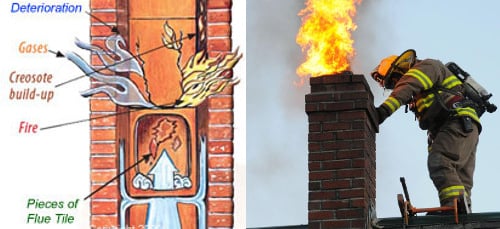Understanding Creosote: The Silent Threat in Your Chimney and How to Safely Remove Itost
Learn how to safely remove creosote buildup in your chimney using creosote logs and removers. Discover the importance of regular chimney cleaning and how to prevent dangerous chimney fires. Keep your home safe with these expert tips!
SAFETY
2/10/20253 min read


What is Creosote?
Creosote is a dark, tar-like substance that accumulates inside chimneys and stovepipes when wood is burned. It forms when smoke, water vapor, gases, and other byproducts of combustion cool and condense on the interior surfaces of your chimney. Over time, these deposits can build up, creating a thick, sticky layer that is highly flammable.
There are three stages of creosote formation:
1. First Stage: A light, flaky layer that is relatively easy to remove with regular chimney cleaning.
2. Second Stage: A thicker, tar-like coating that requires more effort to remove, often needing specialized tools or chemicals.
3. Third Stage: A hardened, glazed layer that is extremely difficult to remove and poses a significant fire hazard.
If creosote is not regularly removed, it can ignite, leading to a chimney fire that can quickly spread to the rest of your home.
---
The Dangers of Creosote Buildup
Creosote is not just a nuisance—it’s a serious safety hazard. Here’s why:
- Chimney Fires: Creosote is highly combustible. When it ignites, it can cause a chimney fire that reaches temperatures of over 2,000°F, potentially damaging your chimney and spreading to your home.
- Reduced Efficiency: Thick creosote buildup can restrict airflow, reducing the efficiency of your fireplace or stove and increasing the risk of carbon monoxide poisoning.
- Health Risks: Creosote contains toxic chemicals that can be harmful if inhaled, especially during cleaning.
---
How to Remove Creosote: Creosote Logs and Creosote Removers
Regular chimney cleaning is the best way to prevent creosote buildup, but there are also products designed to help break down and remove creosote between professional cleanings. Two popular options are creosote logs and creosote removers.
Creosote Logs
A creosote log is a specially formulated log that you burn in your fireplace or wood stove. As it burns, it releases chemicals that help break down creosote, making it easier to remove during your next chimney cleaning. While creosote logs are not a substitute for professional cleaning, they can help reduce buildup and lower the risk of chimney fires.
Creosote Removers
Creosote removers are chemical powders or sprays that you apply to your firewood before burning. These products work by altering the chemical composition of the smoke, reducing the amount of creosote that forms in your chimney. They are particularly useful for preventing second- and third-stage creosote buildup.
---
The Importance of Regular Chimney Cleaning
No matter how diligent you are about using creosote logs or removers, nothing replaces the need for regular chimney cleaning. The National Fire Protection Association (NFPA) recommends having your chimney inspected and cleaned at least once a year, preferably before the heating season begins.
During a professional cleaning, a certified chimney sweep will:
- Remove all stages of creosote buildup.
- Inspect your chimney for cracks, blockages, or other damage.
- Ensure your chimney is functioning safely and efficiently.
Affiliate Opportunity: Partner with local chimney cleaning services or recommend chimney cleaning tools like chimney brushes and rods for DIY enthusiasts.
---
Preventing Chimney Fires
The best way to prevent a chimney fire is to minimize creosote buildup. Here are some additional tips:
1. Burn Dry, Seasoned Wood: Wet or green wood produces more smoke and creosote. Always use wood that has been properly dried for at least six months.
2. Maintain Proper Airflow: Ensure your fireplace or stove has adequate airflow to promote complete combustion, which reduces creosote formation.
3. Install a Chimney Cap: A chimney cap prevents debris and animals from entering your chimney, reducing the risk of blockages that can contribute to creosote buildup.
4. Monitor Your Fire: Avoid smoldering fires, as they produce more creosote. Instead, aim for hot, efficient burns.
---
Creosote Oil: A Lesser-Known Hazard
While most people are familiar with creosote buildup in chimneys, fewer are aware of creosote oil. This is the liquid form of creosote that can seep into the masonry of your chimney, causing long-term damage. If you notice a strong, tar-like odor coming from your fireplace, it could be a sign of creosote oil. Addressing this issue often requires professional intervention to prevent structural damage.
---
Conclusion
Creosote is a silent but dangerous byproduct of burning wood. By understanding how it forms and taking proactive steps to remove it—such as using creosote logs, creosote removers, and scheduling regular chimney cleaning—you can significantly reduce the risk of a chimney fire and keep your home safe. Remember, prevention is always better than cure when it comes to creosote.
This post may contain affiliate links. If you make a purchase through these links, I may earn a small commission at no extra cost to you. Thank you for supporting FirewoodFanatic.com!
